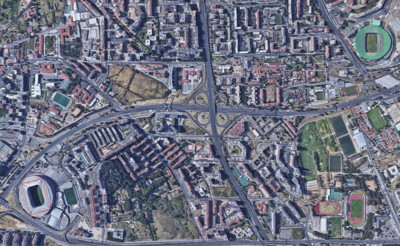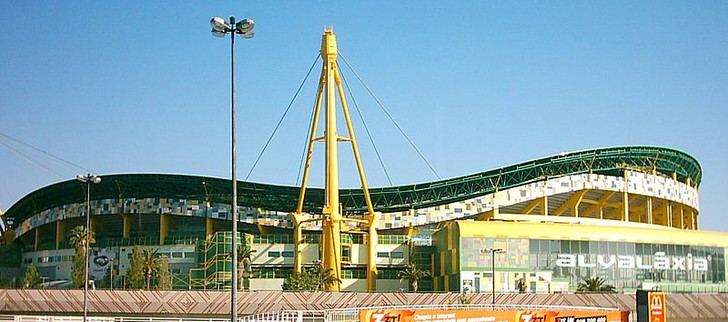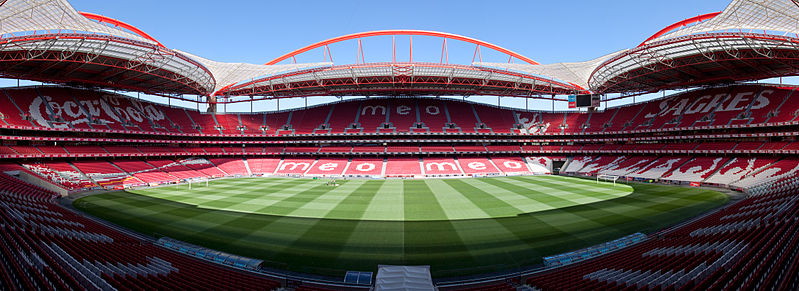 Portugal is a fascinating country to talk about in terms of football. The natives are absolutely mad about the sort and there are a number of teams that anyone with even a passing knowledge of the sport will have heard of. The likes of Boavista, Porto, Sporting CP and Benfica will all ring a bell, with the latter clubs known as ‘The Big Three’ of Portuguese football.
Portugal is a fascinating country to talk about in terms of football. The natives are absolutely mad about the sort and there are a number of teams that anyone with even a passing knowledge of the sport will have heard of. The likes of Boavista, Porto, Sporting CP and Benfica will all ring a bell, with the latter clubs known as ‘The Big Three’ of Portuguese football.
The Portuguese national side has been competing in major tournaments since 1966, making the semi-finals of the European Championships in 1984, 2000 and 2012, with a final appearance chucked in there in 2004 and a semi-final appearance in the World Cup in 2006 also on their list of achievements. They even went on to win the Euros in 2016 when the competition was held in France, yet somehow the Primeira Liga doesn’t garner the same attention and respect as the likes of the Premier League, La Liga and the Bundesliga.
Just as with those leagues, however, there are cities within the country that boast more than one top-class football club. Both Boavista and Porto can be found in the city of Porto, but the one we’re interested in here is Lisbon – the home of both Sporting CP and Benfica. It is the capital city of the country, with a population of around five-hundred and fifty thousand within its administrative borders and an urban population of just shy of three million.
It is a global city, boasting the hubs of Portugals financial, commercial, entertainment and trade industries. One of the oldest cities in the world, pre-dating the likes of Rome, London and Paris, it’s little wonder that two major football clubs call Lisbon their home. That’s to say nothing of Clube de Futebol Os Belenenses, who also ply their trade in the Primeira Liga, nor the fact that country’s previous national stadium, the Estádio Nacional, was also built in the city.
{module Maps – Cities – Lisbon}
Football Stadiums in Lisbon
| Stadium | Capacity | Team | League |
|---|---|---|---|
| Estadio da Luz | 64,642 | Benfica | Primeira Liga |
| Estadio Jose Alvalade | 50,095 | Sporting CP | Primeira Liga |
Sporting Clube de Portugal – ESTÁDIO JOSÉ ALVALADE (2.70 Miles to Academia Militar)

Often called simply Sporting CP, Sporting Clube de Portugal is exactly that – a sports club. It goes without saying that its best known for the football side of things, being able to trace its origins back to the formation of port Club de Belas in June of 1902. Admittedly, that club only played one game before being disbanded, but the foundation was in place for a sports team to be formed in the capital of Portugal. The idea to create such a team never really went away, with two of the brains behind the original club, Horta and José Maria Gavazzo, teaming up with José Alvalade and José Stromp to form Campo Grande Football Club in 1904. They concentrated on football, fencing and tennis initially, also taking time to host parties and picnics. To passionate football supporters of the modern era what happened next might seem crazy, but there was a major disagreement amongst those involved with the club when some felt it should focus on those social activities and others believed sport was the most important thing.
As a result of that passionate falling out, the club split. José Gavazzo and José Alvalade, along with around seventeen other people, left the club with the specific intention of setting up a sports club that they believed would be ‘as great as the greatest in Europe’. That’s when Campo Grande Sporting Clube was formed, with a suggestion made on the first of July 1906 that they change the name of the club to Sporting Clube de Portugal. That date is now considered to be the official founding date of the club, though the earlier iterations of it certainly add to the idea that, whilst it has always been about more than just football, that is the sport that matters most to all concerned. The club’s first match as ‘Sporting’ took place on the third of February 1907, though it’s not a match that many people will care to remember. A 5-1 loss to a third division side named Cruz Negra is not the sort of result that any newly formed club, full of energy and vitality, wants to endure.
1907 was also the year that the sports club inaugurated their first stadium. Sítio das Mouras was known as the most advanced sports ground in the country at the time, boasting tennis courts, showers, an athletic track and, of course, a football pitch. The club continued to go from strength-to-strength, starting a tradition in 1922 that continues to this day when they released what was essentially a ‘report card’ on the state of play, known as the Boletim do Sporting. Today it’s called the Jornal do Sporting and is the club’s official newspaper. In terms of rivalries, the early days of the club also saw them play their first derby against Benfica on the the first of December 1907, which they won 2-1. The two compete in the Eternal Derby, as the match is known, to this day.
When it comes to the rivalry between the two sides, it’s always been somewhat intense. As with most derbies, it is steeped in history. The first real flare up came back in 1907 when a selection of Benfica players left the team to start playing for Sporting. In 1986 Sporting secured their biggest win over their neighbours, beating them 7-1. The match between the two sides in 1994 is probably better known, however, given what it meant for the destination of the league title. It was played at Sporting’s ground and they were very much the favourites, yet the underdogs of Benfica left with a 3-6 win before going on to win the title themselves. There’s also a strong rivalry between Sporting and FC Porto, with the Lisbon side the third-most successful of ‘The Big Three’. They’ve won the Primeira Liga eighteen times at the time of writing, as well as the European Cup Winners’ Cup in 1964.
When it comes to the stadiums that Sporting have played their games in, they moved to a ground named Estádio de Alvalade in 1956. The remained in that location until a decision was taken to demolish it in order to build a better ground ahead of Portugal’s hosting of the European Championships in 2004.The old ground was demolished in 2003 and the new Estádio José Alvalade opened on the same spot on the sixth of August that same year. The first match was a 3-1 win over Manchester United and it went on to be used for five different matches during the 2004 European Championships. In 2005 it was classified as a 5-star venue, meaning that it could host that year’s UEFA Cup final that, coincidentally, featured Sporting CP and CSKA Moscow. Unfortunately home advantage didn’t count for much, with CSKA winning 3-1.
Sport Lisboa e Benfica – ESTÁDIO DO SPORT LISBOA E BENFICA (3.07 Miles to Academia Militar)

Though the club is most commonly known simply as Benfica, its full-name is actually Sport Lisboa e Benfica. As with Sporting CP, Benfica is a sports club rather than just a football club. The success enjoyed over the years, which has made it the most successful club in the country, has meant that the major concentration will always be football, however. It will almost certainly go without saying given Benfica’s immense success since the club’s formation, but it is one of the ‘Três Grandes’, or ‘Big Three’ of Portuguese football. Boasting the nickname ‘águias’, which translates as ‘The Eagles’, the club’s crest features one of the birds on top of it. At the time of writing Benfica have picked up nearly forty Primeira Liga titles, a record number of domestic cups and back-to-back European Cups in 1961 and 1962. They are the only Portuguese side to manage that, having also finished as runners-up in the same competition five more times.
Back to the club’s inception, however, and it took place at around the same time that Sporting CP was being created. Sporting can trace their history back to around 1902, with Benfica being created on the 28th of February 1904. Members of Associação do Bem met in the back of a pharmacy and decided to form a social and cultural club that would play football under the moniker of Sport Lisboa. There were twenty-four people there, including José Rosa Rodrigues, who was appointed the first club president. They decided upon red and white as the club’s colours, leading to another nickname of ‘encarnados’, or ‘The Reds’. They played their first game of football on the first of January the following year, yet the poor conditions of the football pitch at Terras do Desembargador led to several players deciding to leave in order to join Sporting CP in 1907.
The change of name to the one that the club currently boasts came about on the thirteenth of September in 1908. That was the date on which the club acquired Grupo Sport Benfica, becoming Sport Lisboa e Benfica. They continued to be run as two separated entities, though, with Sport Lisboa concentrating on the football side of operations and Grupo Sport Benfica remaining at Campo da Feiteira and keeping the club house there. A cycling wheel was added to the club crest, with cycling being the most important sport of Grupo Sport Benfica at the time. The club was one of the founding members of the Primeira Liga and, along with Porto and Sorting CP, have never been relegated from it. That may, perhaps, be part of the reason why it’s Portugal’s most popular football club, with supporters being known as benfiquistas.
We’ve already made passing mention to the rivalry shared between Benfica and Sporting CP, but we’ll tell you a little bit more about that now. The Derby de Lisboa is easily the biggest in Portuguese football, perhaps being equitable to the rivalry between the like of Manchester United and Liverpool in the Premier League, or Barcelona and Real Madrid in Spain. The biggest difference, of course, is that the two teams are based in the same city. Benfica’s biggest win over their city rivals is a victory by a five goal margin, something that they’ve achieved on four occasions. They also managed to beat Sporiting CP 4-0 in 1910, an away scoreline that has yet to be bettered. Though the rivalry between the sides has always been tense, it took a turn for the worse in 1996 during the Portuguese Cup final when Benfica took a 1-0 lead and a supporter let a flare. It hit a Benfica supporter in the chest and he died instantly. In 2011, Sporting supporters set fire to one of the stands in the Estádio da Luz after they watched their side lose 1-0.
When it comes to the places that Benfica have called home, it’s only been in relatively recent times that they have been able to escape from rented stadiums. They bought their first ground, Estádio das Amoreiras, in 1925, playing there until 1940. After that it was another rented stadium for them in the form of the Estádio do Campo Grande, which they continued to use for the next thirteen years. In 1954 they moved to the Estádio da Luz, remaining there until 2003 when, much like with Sporting CP’s ground, it was demoted and rebuilt ahead of Portugal hosting the European Championships in 2004. Between 1985 and 1987 the original Estádio da Luz boasted the largest capacity in Europe thanks to its 120,000 seats. The new Estádio da Luz cost just shy of €119 million to build, hosting a number of matches in the Euros including the final. In 2014 it hosted the Champions League final between two other city rival teams, Real Madrid and Atlético Madrid.
